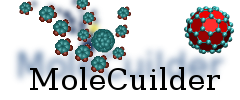| [df9cbd] | 1 | /*
|
|---|
| 2 | * Project: MoleCuilder
|
|---|
| 3 | * Description: creates and alters molecular systems
|
|---|
| 4 | * Copyright (C) 2010 University of Bonn. All rights reserved.
|
|---|
| 5 | * Please see the LICENSE file or "Copyright notice" in builder.cpp for details.
|
|---|
| 6 | */
|
|---|
| 7 |
|
|---|
| 8 | /**
|
|---|
| 9 | * \file linkedcell.dox
|
|---|
| 10 | *
|
|---|
| 11 | * Created on: Nov 15, 2011
|
|---|
| 12 | * Author: heber
|
|---|
| 13 | */
|
|---|
| 14 |
|
|---|
| 15 | /** \page linkedcell Linked Cell structure
|
|---|
| 16 | *
|
|---|
| 17 | * The linked cell ansatz is used to obtain neighborhoods of particles in
|
|---|
| 18 | * \f${\cal R}^3\f$ more quickly than in \f${\cal O}(N^2)\f$ if \f$ N \f$ is
|
|---|
| 19 | * the number of particles. We require a maximum length, beyond which no more
|
|---|
| 20 | * neighbors are sought. With this length we place a mesh on top of our space
|
|---|
| 21 | * and associate each particle with a specific cell in this three-dimensional
|
|---|
| 22 | * mesh, i.e. per cell we have a linked list containing references to all
|
|---|
| 23 | * particles that are located in this cell (i.e. whose coordinates are bounded
|
|---|
| 24 | * from above and below per coordinate axis by the cell's intervals). Eventually
|
|---|
| 25 | * this allows for a complexity of \f${\cal O}(N \log N)\f$.
|
|---|
| 26 | *
|
|---|
| 27 | * \section linkedcell-structure Code structure
|
|---|
| 28 | *
|
|---|
| 29 | * The code is structured as a Model-View-Controller ansatz. The reason is as
|
|---|
| 30 | * follows: The required edge length is not known at compilation but is a
|
|---|
| 31 | * value depending on run-time variables. However, we must not re-initiate a
|
|---|
| 32 | * linked cell structure whenever a slightly different edge length is requested.
|
|---|
| 33 | * Instead we may use an already present linked cell instance that more or
|
|---|
| 34 | * less (via some heuristic) matches the desired edge length. This slightly
|
|---|
| 35 | * degrades asymptotic performance but enhances pre-asymptotics because we
|
|---|
| 36 | * don't have to re-build a linked cell instance each and every time.
|
|---|
| 37 | *
|
|---|
| 38 | * We briefly explain
|
|---|
| 39 | * each part:
|
|---|
| 40 | * -# \link LinkedCell_Model Model\endlink:
|
|---|
| 41 | * The model represents a certain representation of the data( here a
|
|---|
| 42 | * specific edge length), i.e. it is a specific instantiation of a linked
|
|---|
| 43 | * cell structure.
|
|---|
| 44 | * -# \link LinkedCell_Controller Controller\endlink:
|
|---|
| 45 | * The controller contains the heuristic criterion and all
|
|---|
| 46 | * present linked cell instances. It decides when new ones are required and
|
|---|
| 47 | * when old ones are no longer needed.
|
|---|
| 48 | * -# \link LinkedCell_View View\endlink:
|
|---|
| 49 | * The view is the interface of the whole to the outside, here the
|
|---|
| 50 | * user requests high-level functions, such as getAllNeighbours. How these
|
|---|
| 51 | * are then performed is none-of-his-business but encapsulated below.
|
|---|
| 52 | *
|
|---|
| 53 | * This ansatz makes it possible to even implemented k-Nearest-Neighbor trees
|
|---|
| 54 | * instead of a linked cell ansatz if it is more convenient (e.g. if constant
|
|---|
| 55 | * updates are required). A single cell of the linked cell array is implemented
|
|---|
| 56 | * in LinkedCell for greater convenience, e.g. we store the array indices there
|
|---|
| 57 | * and may add further commodity functions.
|
|---|
| 58 | *
|
|---|
| 59 | *
|
|---|
| 60 | * \section linkedcell-howto How to use the code
|
|---|
| 61 | *
|
|---|
| 62 | * In this section we explain how you, as the user, is supposed to use the code.
|
|---|
| 63 | *
|
|---|
| 64 | * The following snippet gives you access to the linked cell interface.
|
|---|
| 65 | * \code
|
|---|
| 66 | * LinkedCell_View &interface = World::getInstance().getLinkedCellView();
|
|---|
| 67 | * \endcode
|
|---|
| 68 | *
|
|---|
| 69 | * Now, you can access its functions as simply as
|
|---|
| 70 | * \code
|
|---|
| 71 | * LinkedList &list = interface.getAllNeighbours(Vector(0.,0.,0.), 4.);
|
|---|
| 72 | * \endcode
|
|---|
| 73 | * which returns a LinkedList, i.e. a set of points, that reside in a sphere
|
|---|
| 74 | * around the origin of radius 4. where the boundary conditions apply as are
|
|---|
| 75 | * current in the Box stored in the World:
|
|---|
| 76 | * \code
|
|---|
| 77 | * World::getInstance().getDomain()
|
|---|
| 78 | * \endcode
|
|---|
| 79 | *
|
|---|
| 80 | *
|
|---|
| 81 | * \date 2011-11-30
|
|---|
| 82 | *
|
|---|
| 83 | */
|
|---|
